Our next stop in Costa Rica is to Monteverde. Despite our hostel hosts telling us the only way there is to go back to San Jose and starfish our way back east and then north, I’ve found a couple of suggestions online that it’s possible to go ‘direct’. Inspired by the many travellers we’ve met who just show up at bus stations and figure their journey out in the moment, we decide to do the same. Well, almost!
I have managed to find out that there’s only one bus we can take from mid-point Puntarenas to Monteverde. So, we set off as early as possible from our hostel to make sure we don’t miss it. The first leg is easy and goes smoothly. We could get used to this! Arriving to Puntarenas we now have four hours to kill until the transfer. A man offers to help us find information we need. I don’t want to be rude and figure I can confirm some of the things I wasn’t able to find out online. He confirms what I know, and we part ways, or so we think…
It’s already pretty warm in Puntarenas and with all our bags and James suffering from some sinusitis, we park ourselves up in a beachside bar and decide to try out something we’ve read on the blogs called a Churchill. On our menu, there is a Super Colossal Churchill, and we decide to go halves on it.
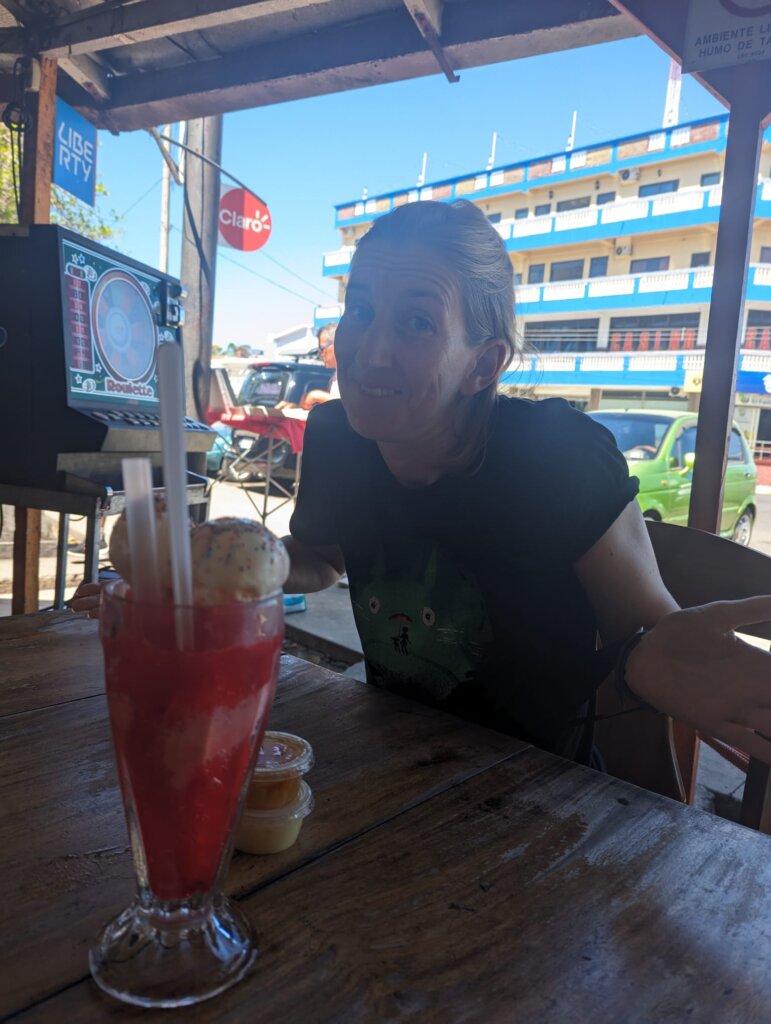
There are no less than five types of sugar in this: syrup, ice cream, sprinkles, condensed sugar, and canned fruit. Even for sugar-loving me, it’s too much.
This manages to successfully kill at least half our time though, and a group of loud and drunk (at 10:30am) Latinos perch up at the bar, smash a bottle, and proceed to give us good reason to move on. One even sports a tattoo off an AK47 on his face. Compared to Manuel Antonio, Puntarenas seems like the Costa del Sol of Costa Rica.
Our priority is to try and find somewhere with at least a fan, because we’re really starting to melt now as we hit midday. Everywhere is just beachfront open with no ventilation at all. Definitely catered to the Latinos and not the gringos in this part! As we plod towards a place on the corner, we hear “England!” and notice the ‘helpful’ man from before sitting at a bench we’re walking passed. I smile and say “Hi” back as we keep marching on, to him calling out “don’t forget to tip me on your way out”. This seems more like a threat than a reminder, and so the ‘helpful’ man has now turned into the ‘threatening’ man. As we sit down at the corner restaurant, we cool off under a big fan, but sweating at this perceived threat whilst we try and enjoy our overpriced burger and chips.
Time sufficiently killed, we make our way to the ‘bus-stop’ to get our bus out of dodge. If it wasn’t for the blogs, Google maps, or the gringos huddled in the limited shade, you’d never know this was a bus-stop. Thank you Internet! The driver helpfully shows me where to store our big backpackers in a way that means I essentially get to put my feet up the entire journey with loads of space, what a gem. Despite warnings from said blogs of the bus being full and needing to stand and not having aircon, we enjoy our second naturally air conditioned ride into the mountains.
I come to a realisation that I really enjoy bus journeys. There’s no Internet on these buses and I don’t have data. Reading makes me travel sick. So, all I can do is stare out the window and enjoy the ride, or try and make a dent in my neverending podcast queue. I love it. It forces me to take the time to process my thoughts and put my mind in order. No distractions but the amazing views. I got to enjoy these a lot when we started our travels, but recently we’ve not really had many. Once hated bus journeys are now something I miss. Put me on a bus over a plane any day!
As the bus, that is more like an inner city bus, struggles up through and over the windy and bumpy roads, the sun sets beside us, behind layers of green rolling cloud forest, creating a stunning, misty silhouette. It’s gorgeous in a whole different way to the sunset over the Pacific, and we realise just how high up we’ve come.
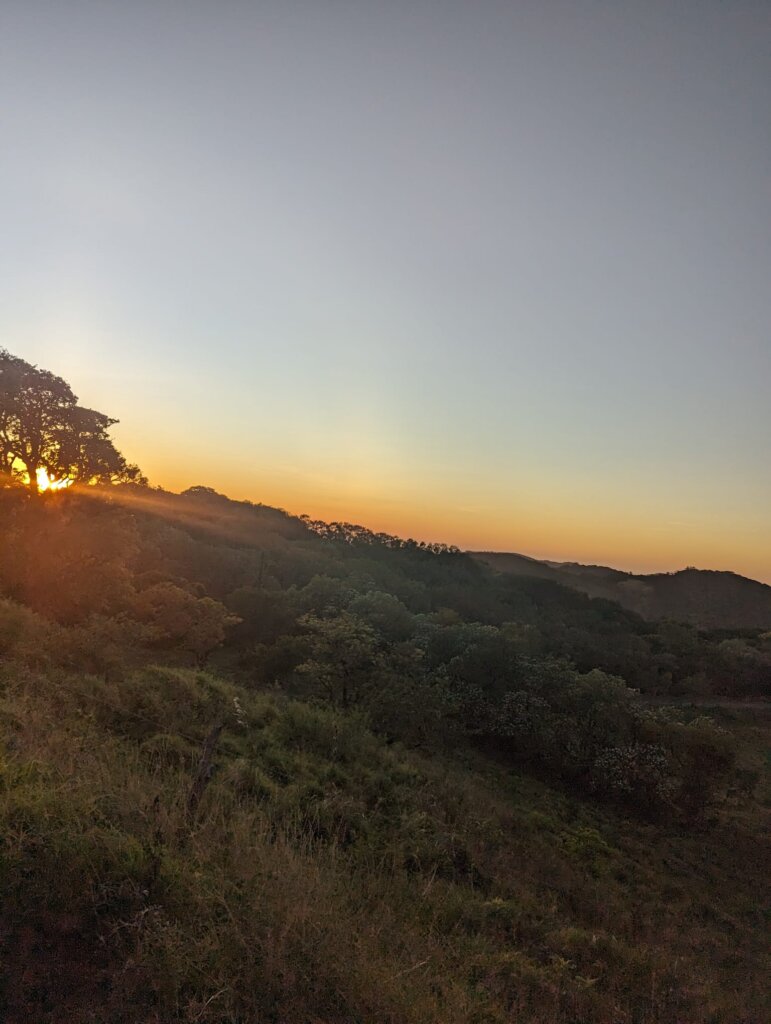
Soon enough, we arrive to Santa Elena, the town attached to the Monteverde tourist region. This area is smack-bang in the cloud forest, and we appreciate the cool air on our skin once more. A nice respite from the 40° real feel we left behind at the coast.
Monteverde Cloud Forest
We’ve read that spotting animals in the cloud forest is a hundred times harder than down at the coast, so we splash out on a guided tour. Our guide today is Mauricio, and he does an amazing job teaching us all about cloud forests and this particular one we are exploring today.
Our previous experience of a cloud forest was in Peru on the Inca Trail, and this brings back fond memories. There’s something about being in the cool, damp air, surrounded by an abundance of life that is just indescribable and I’m back in awe at the nature all around us. If you took just one foot squared of any part of this area, you’d struggle to count the variety of flora it contains. From different types of moss, to plants, to ferns, to flowers, to vines… and every variety of those on top of one another again. It’s just a beautiful, harmonious, peaceful and symbiotic place. I’d say that humans are insignificant here, a bit like how we felt on the Inca Trail, but Mauricio tells us how climate change is changing this region and drying it up. I guess humans have their impact here after all.

(Photo technically from Arenal but I didn’t take an equivalent in Monteverde)
Whilst Odi taught us about pachamama, Mauricio teaches us about the science of this area. Cloud forests only exist in The Americas. They happen when hot air meets cold air at a certain altitude. If you remember, this is a similar case for glaciers, but obviously a lot higher up! Cloud forests makes up only 1% of all forests in the world. We feel very lucky to have experienced it twice now.
We learn about three types of plants, epiphytes (60% of plant species here, mostly orchids), hemiepiphytes (typically vines), and parasites. The difference lies in how much they withdraw from the plant they are living on, from epiphytes that merely lay on top of the plant, to parasites that kill the host plant. It’s nice to know that these plants on top of plants on top of plants aren’t actually killing one another, but rather have found ways to survive together. We learn that most of the plants here get their nutrients from the air, rather than the soil, which is part of why they live so on top of each other to get into the cloud as much as possible rather than be rooted in the ground. Many of these plants start up above and grow downwards, which is why you have all the dangling roots everywhere. Fascinating.

We also learn that because this climate is just wet or more wet, the trees don’t have rings like they do in other climates. The rings form from each winter a tree lives through, and because there is no winter here, there are no rings!

Mauricio shines his light into a dark hole bordered by string and poles, as we peer in, I jump back to see a big, hairy tarantula.
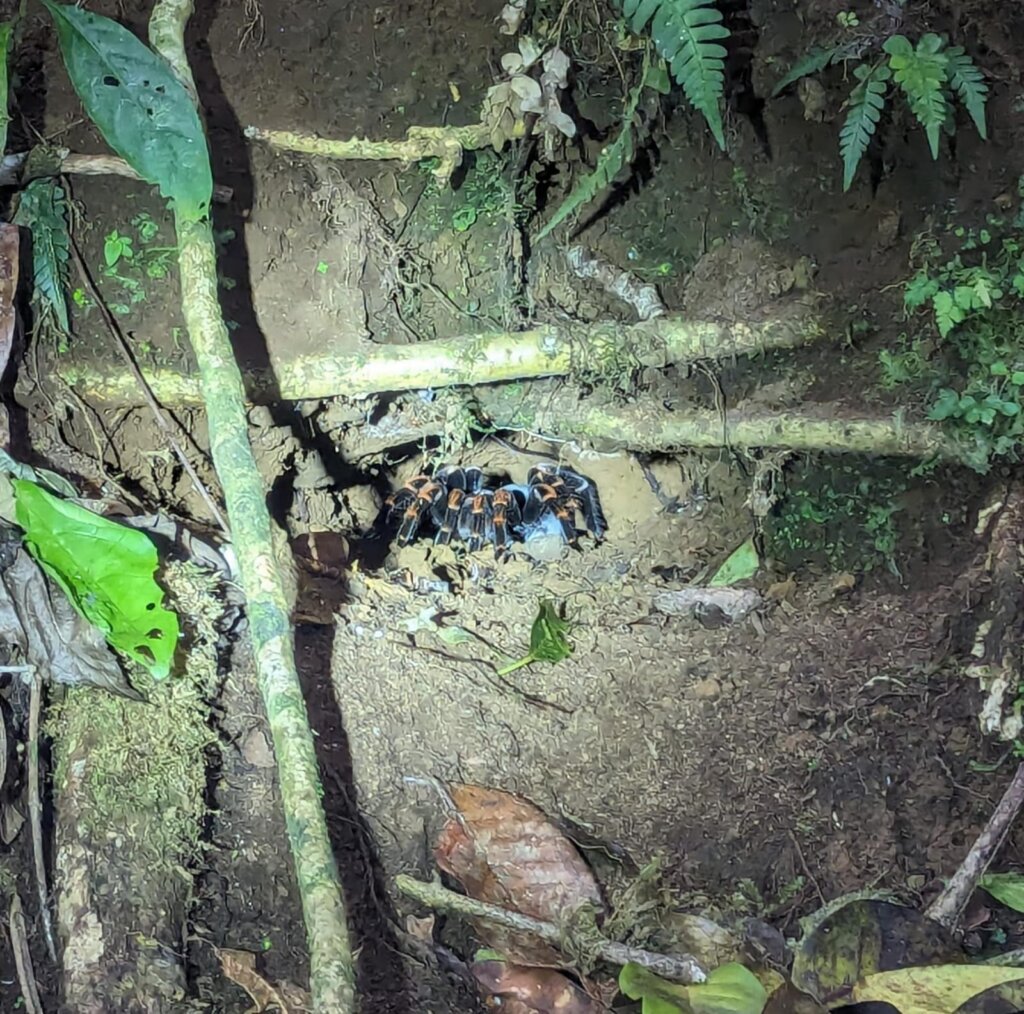
We’re told how she’s blind and can only hunt by vibration. This explains how we can have a torch right in her face and she doesn’t move. Why so many eyes then?! The females apparently stay home to nest all the time, creating a ping pong full of up to 40 baby tarantulas. Once popped, they must scatter otherwise they would eat each other. Lovely.
Onto less terrifying fauna, we see a cute hummingbird out for nectar in a nearby flower. Hummingbirds are also only found in the Americas! They’re also the only bird that can fly backwards, as instead of flapping their wings, they move in a figure of eight. To do this fast enough, their heart beats ridiculously fast, meaning they have a ridiculous metabolism, and have to eat n times their body weight to survive. Sounds like my kind of bird. They are also the second most varied bird in the world. The most varied mammal is the bat!
The cute fauna department ups the game as some pig/raccoon creatures appear on our path. They’re snuffling around in the leaves and undergrowth for bugs, carefree of the gawking, camera-pointing humans all around them. Mauricio tells us they are called Coatis.


Next up in the cute stakes, it’s time for Mauricio to get out his telescopic lens and show us a nesting hummingbird.
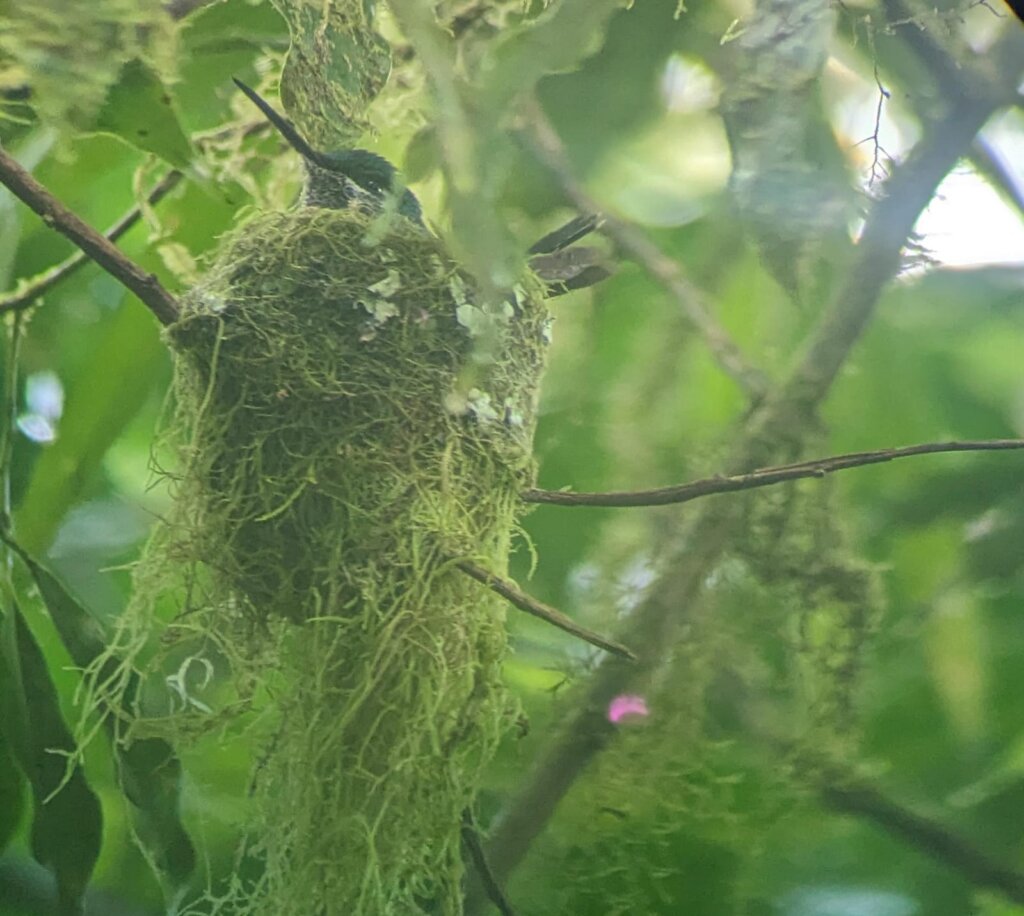
Moving from cute to functional, one of our group spots a millipede that is black and yellow. One that monkeys apparently rub on themselves to deter mosquitoes because they have cyanide on their skin. Unfortunately not something recommended for humans.
After a few more lessons about the African Violet flowers, that many plants here are related to many of our house-plants, that much of the flora here are old cousins of our domesticated plants like the Arabica coffee plant (that you can identify because their leaves grow two-by-two opposite one another), it’s time to search for the elusive Resplendent Quetzal.

All around this forest are cousins of the avocado tree, that grow tiny avocados the size of olives. This means that in these trees you’ll often find fauna, including this spectacular bird. So we stand and stare into the trees hoping one will grace us with its presence, to eat, and then regurgitate it for half an hour. Yum.
Unfortunately, we have no luck here. The group moves on. I’m the last in the pack still staring out to the trees, where I think I see a slightly different green from the huge array before me. But then I lose my gaze. I tell James I think I saw something, to come back. It’s hard to find the same spot of green amongst a wall of green twice. Eventually I spot it again. An unmistakable turquoise. I tell James to get the group and binoculars, but our group has moved on so far that just as James makes it back to be with some borrowed binoculars, the turquoise blob flies off with a splash of red. Now I definitely know I’ve seen it, but it’s now gone behind a different tree. We make our way back to the group who are around the other side of the tree, still looking out. Just as I am about to say it was there, Mauricio spots it:

It’s not at the best angle, but we can see it, and Mauricio helps us take photos. It then flies off once more, but this time to the opposite side of the path, where we can see its magnificent tail feathers, that shimmer and change colour in the light:

After this win, it’s time to head out of the park and to the Hummingbird Cafe. One of the only free things available in this area. There are sugar water feeders all over and hummingbirds of all different colours and sheens flutter around us. There are turquoise, green, orange and purple ones. They’re glorious, as this lady on the left’s expression gives away:



Mauricio leaves us all entranced by the tiny fluttering, shimmering, flying joy, where James and I enjoy a clandestine packed lunch on a bench in the corner, before making our way back into the park. With Mauricio we only did one trail, and there’s a whole other five that need exploring. After all, we wouldn’t be who we are if we didn’t do ourselves in for the sake of making sure each trail is completed. Plus I love it in there, and we still haven’t seen a toucan, so let’s go exploring!



James is still suffering from his cold, but does a fantastic job powering through, even when we get to the final leg and realise we’re close to missing our transfer (and only way) back. Cue a quick run/walk through the final stretch to make it just in time.

Downtime and Night-time
The next day James is still under the weather and with everything here costing a small fortune to just look at, we decide to spend the day relaxing and recovering. At least, for the most part. I decide I want to do a Night Tour as my final farewell to Monteverde, and find the cheapest, well rated one possible. James opts to keep chilling out at the hostel.
After some last minute chaos and confusion getting to the tour, I find myself in a group with two women from the USA, two Brits and two Romanians, with our guide Olman. We’re each handed a torch and head into the dark.
Our first spot is an absolutely tiny pygmy frog, that’s about the size of a thumbnail:

After this we see a glass frog. Olman does a great job capturing its cute face up close:

Olman tells us about the area and the animals we can hear around us. The surroundings are alive with noise from nature. He tells us that everything we can hear around us is created by crickets, and only male crickets, as females don’t make noise. He teaches us that crickets with long antenna are night crickets, those with short antenna would be day crickets. One way to identify a male or female cricket is to look at its behind. If it looks like it has a stinger, then it’s a female, as that’s where it incubates its eggs.
We hear a rustle in the trees above, and spot a cousin of the Coati I’ve seen yesterday, the Olingo. It’s quite far away, but we can see it playing around. One of the women from the USA has a camera with a foot-long lens and she’s right in the undergrowth trying to get a photo. “Just be careful”, Olman warns, “we saw a snake right at arm-height in this part the other day”. The lady is undeterred whilst the rest of us spin our torches around us.
The olingo scampers off, and we’re back on the trail. As I shine my torch to the right, less than a foot away from my arm, I notice the distinctive bright green body of a snake, just like what we saw in Manuel Antonio. “Er, snake”, I calmly say, as I stop with my torch illuminating its body. Olman jumps not to action, but to panic… “Everyone, quick, over here, move away!” Olman orders. We move up the trail away from the snake as Olman explains this snake is not like the others. It’s actually a Side-Striped Palm Pit Viper.

This beaut is actually highly venomous and would kill us. It can deliver a deadly combination of venom that not only would coagulate our blood, but also paralyse and kill the muscles by the bite. There’s no anti-venom for this here. And here I was thinking it was just another harmless Green Parrot snake!

With myself now crowned head spotter, the group take Olman’s warnings more seriously about staying on the path, just as we hit a swarm of fire ants, and he orders us to run through, and then checks us all for any stowaways. I’ll be honest that I can’t tell if this is serious or a joke to make a bunch of gringos stomp around like muppets in the dark.
Olman tells me that snakes are far more dangerous in this country than any spider. Maybe that’ll help the arachnophobia, or it’ll spark a snake one! He points out a few spiders I don’t care to photograph, including a ‘fishing spider’ that contorts itself into a single stick-shape dangling from its thread, it looks just like a dead leaf or stick caught and you wouldn’t think anything of it. The more I learn about some spiders, the cooler I think they are. But I still wouldn’t want one in my room!
We are introduced to a stick-bug, “that lives and behaves just like a stick”, can you spot it?

Then it’s time for my favourite, the elusive toucan! This time, there’s no flying off as it’s literally caught sleeping. Mission accomplished!

Olman tells us about the strangling ficus tree I’ve now seen ample times, but this time we get to go inside one. The strangling ficus grows from the top down of an existing tree, wrapping its roots around the host, eventually cutting it off from all light. At this point, the original tree dies and rots into the group, leaving the ficus hollow. “Tell me, have you ever been inside a tree before?”, Olman asks us all as we step inside.

These trees really are like incredible mythical beings that we always imagine coming to life, like Ents in Lord of the Rings.
Our last two ‘exhibits’ are a citronella flower, best rub that all over me!

And a rhinoceros katydid (or long-horned grasshopper):

I’m more than satisfied with all that we’ve seen and get back to tell James all about my spot of the snake and seeing the toucan as we enjoy a dinner of roast chicken and chips from a takeaway.
Tomorrow we’re off to La Fortuna, known for its adventure tourism, content that we’ve made a good go at experiencing Monteverde.
***********
Adventure – Being able to properly appreciate a cloud forest after rushing through one on the Inca Trail. Running through the forest to make our ride home. Looking everywhere for a toucan, the search continues (James). Feeling like being in a real life Fern Gully (the original Avatar film).
Excitement – Seeing so much diverse wildlife and amazing plants (again). Seeing amazing night-life and being unknowingly close to death from a lethal snake. Finally seeing a toucan (Alex). Finding an appreciation for buses. Marvelling at the incredible shimmering colours nature can create on birds like the quetzal and hummingbirds.
Trauma – Sleeping next to a busy road with paper thin windows once again. WiFi in the hostel only working in the lobby. Squeezing extra people into a tiny mini-bus we’d paid good money for. The hostel shoo-ing away my transfer to the night tour. Threatening man. Paying £2 for the world’s smallest bell pepper. Churchill.
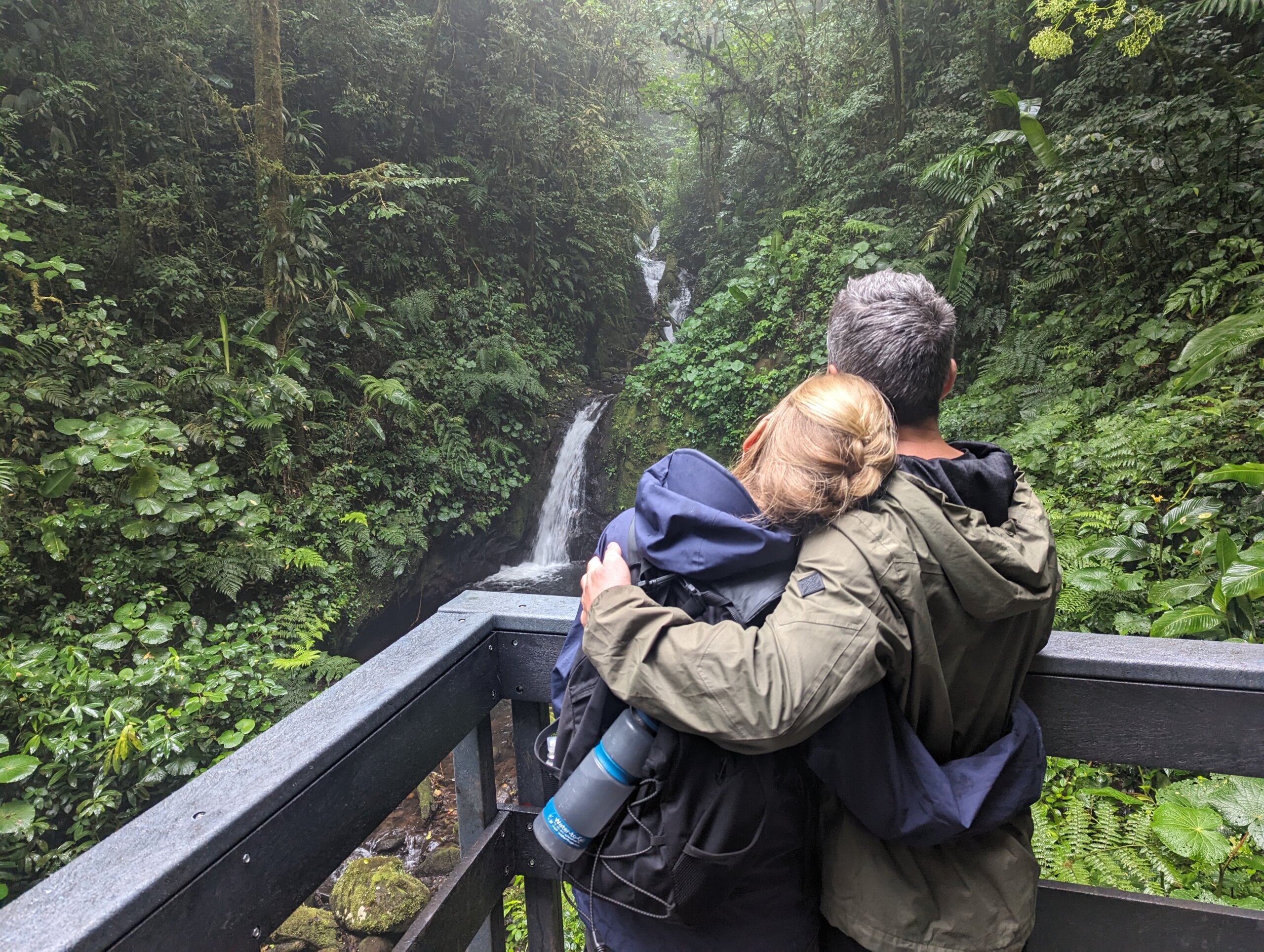
1 Comment
Well that was an intense one! Dodgy humans and deadly creatures at every turn! Very impressive wildlife photography with your phones too!
Eddie saw a photo on WhatsApp of you both in shorts and t shirts and was completely dumbfounded.